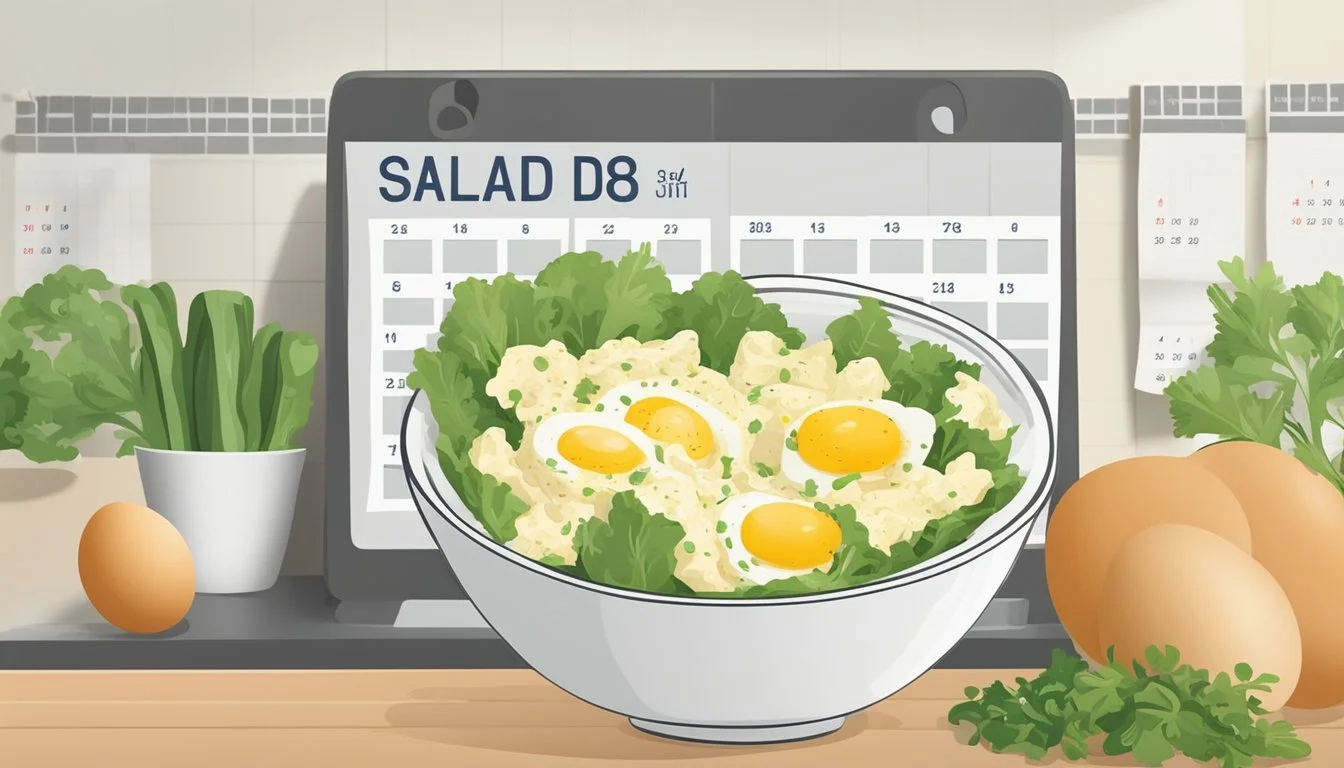How Long Does Freshly Prepared Egg Salad Last?
Shelf Life and Storage Tips
Egg salad is a classic, versatile dish that can be enjoyed on its own or as a sandwich filling. For those who prepare egg salad at home, understanding its shelf life is crucial to ensure both taste and food safety. Properly stored in the refrigerator at or below 40°F in an airtight container, freshly prepared egg salad can remain safe to eat for 3 to 5 days.
Food safety is paramount when dealing with perishable items like egg salad, which contains eggs and mayonnaise that can become breeding grounds for bacteria if not handled correctly. It's important to consider that the timeframe for egg salad's freshness can be reduced if the dish has been kept at room temperature for more than two hours, or one hour if the ambient temperature is above 90°F. The consistent cool temperature of a refrigerator slows bacterial growth, hence storing egg salad promptly and correctly is essential.
Consumers should also be aware of their egg salad’s condition by regularly checking for any off-putting odors, discoloration, or texture changes. If in doubt, it is safer to discard the egg salad rather than risk foodborne illness. The freshness of egg salad is not only a matter of taste but also of health, thus adhering to storage guidelines helps to enjoy the dish safely within its optimal period.
Understanding Egg Salad Composition
The freshness and shelf life of egg salad are highly dependent on its ingredients and the way they interact with each other.
Role of Ingredients in Preservation
Egg salad typically consists of chopped hard-boiled eggs and a dressing, often made from mayonnaise, which acts as a binder and contributes to its creamy texture. Mayonnaise is an emulsion of oil, egg yolks, and an acidic liquid, usually lemon juice or vinegar, which can slightly inhibit bacterial growth and prolong the shelf life of the salad. In some recipes, Greek yogurt or mustard might be added, both of which can affect flavor and preservation. Greek yogurt can introduce beneficial bacteria and mustard can contribute to flavor and has minor preservative qualities due to its acidity.
Mayonnaise: Helps bind ingredients and add creaminess. May shorten shelf life due to egg content.
Lemon juice/Vinegar: Introduces acidity, which can help preserve the salad.
Greek yogurt: Offers a healthier alternative with good bacteria.
Mustard: Provides flavor and a slight preservative effect.
Factors Affecting Egg Salad Freshness
Numerous factors impact the freshness of egg salad. One crucial element is the temperature at which the salad is stored. It should be kept at 40°F (4°C) or cooler to ensure safety. The presence of mayonnaise is a double-edged sword; it provides flavor and a lush, creamy consistency, yet it can shorten the salad's lifespan due to its egg content which is prone to bacterial growth.
Temperature: Should be stored below 40°F.
Airtight container: Essential to protect from contaminants and moisture.
Hygiene: Using clean utensils to avoid introducing bacteria.
The composing elements of egg salad must be carefully balanced to craft a flavorful, nutritious meal that remains fresh as long as possible.
Safe Egg Salad Storage Practices
Proper storage of egg salad is crucial in extending its freshness while ensuring food safety. The specifics are in the temperature control and the type of container used.
Optimal Refrigeration Temperature
Egg salad should be refrigerated at a consistent temperature to maintain its quality and safety. The United States Department of Agriculture (USDA) recommends:
Refrigeration at 40°F (4°C) or colder: This temperature inhibits bacterial growth.
Prompt refrigeration: Egg salad should be placed in the fridge within two hours of preparation, or one hour if the ambient temperature is above 90°F (32°C).
Airtight Containers and Wrapping
The choice of container or wrapping has a significant impact on the longevity and safety of refrigerated egg salad:
Airtight containers: These are ideal for storing egg salad. A container with a tight-fitting lid, whether plastic or glass, prevents exposure to air and contaminants.
Aluminum foil and plastic wrap: If an airtight container is not available, wrapping the egg salad in aluminum foil or plastic wrap can provide a temporary solution. However, this may not be as effective in preventing moisture loss and protecting from odors or cross-contamination.
Containers should be checked for a proper seal, and any leftover egg salad must be packed correctly before refrigeration. Use clean containers and ensure that they are not overcrowded, as circulation of cold air is essential for proper refrigeration.
Identifying Spoilage Signs
When assessing egg salad for spoilage, it is crucial to examine several factors, from the visual cues to the consistency. Being vigilant can help prevent foodborne illness.
Visual and Olfactory Indicators
Smell: A fresh egg salad has a mild, creamy scent. If the salad emits a sour or putrid odor, it indicates spoilage.
Appearance and Color: Initially, egg salad should have a bright, uniform color. Dark spots or discoloration, such as a grayish tint, suggest the salad is no longer fresh. Vegetables within the salad may also lose their vibrant color or become translucent if spoiled.
Texture and Consistency Changes
Mold: Presence of mold, which can appear as fuzzy or dark spots, is a definitive sign the egg salad is not safe to consume.
Texture: Egg salad should be creamy but not excessively runny. If it becomes slimy or the ingredients separate, indicating a breakdown of the emulsion, it is likely spoiled.
Health Implications of Consuming Spoiled Egg Salad
Egg salad is susceptible to bacterial growth, and consuming spoiled versions can result in foodborne illnesses that present serious health risks.
Foodborne Illness Risks
Spoiled egg salad, often a result of improper storage or extended storage time, can harbor bacteria such as Salmonella or Listeria. These pathogens are particularly concerning and can lead to conditions like diarrhea, vomiting, and fever. Symptoms of food poisoning from such bacteria can appear within hours or up to several days after consuming contaminated food.
Perishable foods like egg salad become a breeding ground for bacteria when left at room temperature for more than two hours or one hour if the temperature exceeds 90°F. Thus, it's critical for egg salad to remain refrigerated at 40°F or below and be consumed within a recommended timeframe of 3-5 days to reduce the risk of bacterial growth.
Key Points for Safe Consumption:
Always refrigerate egg salad promptly.
Consume within 3-5 days, keeping storage temperature in mind.
If in doubt or if the salad has been left out too long, it is no longer safe to eat—discard it.
The ingestion of spoiled egg salad can lead to severe dehydration and may require medical attention, especially for more vulnerable populations such as the elderly, young children, pregnant women, and those with compromised immune systems. It's vital to observe strict food safety practices to minimize the risks of foodborne illnesses.
Egg Salad Shelf Life
Proper storage and handling directly affect the shelf life of egg salad. Factors such as temperature and freshness of ingredients determine how long egg salad remains safe and enjoyable to eat.
Typical Refrigeration Timespan
Egg salad should be refrigerated at 40°F or cooler and is generally safe to eat for 3 to 5 days when stored in these conditions. Egg salad must be placed in a sealed container to prevent contamination and maintain freshness.
Factors Influencing Shelf Life
Several variables impact the shelf life of egg salad:
Ingredients' Freshness: Fresh ingredients extend longevity, while older ingredients shorten it.
Temperature: Temperatures higher than 40°F increase the risk of spoilage.
Storage Method: Airtight containers limit exposure to air and contaminants.
Preparation Environment: Clean and sanitary preparation can help prevent the introduction of bacteria.
Alternative Preservation Methods
While refrigeration is the standard method to keep egg salad fresh, one can consider freezing for longer storage, although it might affect texture and quality.
Freezing Egg Salad
Freezing egg salad is not typically recommended, as it can lead to changes in texture that might not be desirable. When the salad thaws, ingredients like mayonnaise can separate, and any vegetables in the salad, such as celery or onions, can become soft and watery. However, if one must freeze it, they should ensure the egg salad is placed in an airtight container to minimize the exposure to air. Freezing can extend the shelf life significantly beyond the typical 3-5 days in the refrigerator, but it's advisable only to freeze plain hard-boiled eggs if they're looking to maintain the quality of the eggs themselves. Plain hard-boiled eggs can be frozen with less quality degradation, although they may still become somewhat rubbery or watery upon thawing.
Serving Recommendations and Uses
When serving egg salad, ensuring its maximum freshness and appeal is paramount. Carefully considering the manner of presentation and innovation in recipes can significantly enhance the enjoyment of this classic dish.
Best Practices for Picnics and Events
For picnics and larger gatherings, maintaining the appropriate temperature is crucial to prevent foodborne illness. Egg salad should be kept below 40°F until serving time. When transporting egg salad to an event, it is recommended to use insulated coolers with sufficient ice packs. Additionally, the salad should not be left unrefrigerated for more than two hours, or one hour if the outdoor temperature exceeds 90°F. To serve, one might consider individual portions to reduce the risk of the entire batch being out in warm temperatures.
Picnic Serving Tips:
Use insulated coolers.
Ice packs are essential.
Do not leave egg salad out for more than two hours.
Consider individual portions for longer lasting freshness.
Creative Egg Salad Variations
While traditional egg salad is a beloved classic, there are numerous variations that can elevate this dish to new levels. For a more nutritious meal, adding ingredients like chopped celery, onions, or a sprinkle of paprika can introduce new textures and flavors. Egg salad can also transcend the typical sandwich filling role; it pairs well with a bagel for breakfast or can be served atop crackers for a protein-rich snack.
Variation Ideas:
Bagel Topping: A savory twist on a breakfast staple.
Cracker Companion: A simple yet satisfying snack.
Sandwich Filler: The classic egg salad sandwich never disappoints.
Expanding the versatility of homemade egg salad encourages both creativity in the kitchen and the enjoyment of this versatile dish in a variety of settings and styles. Whether keeping it classic for a picnic or trying out new variations for daily meals, egg salad remains a convenient and customizable option.
Accompaniments and Add-Ins
When considering add-ins for freshly prepared egg salad, the focus should be on complementing the egg's creamy texture and subtle flavor. The right choice of vegetables, herbs, and other flavorings can elevate this simple dish to a flavorful delicacy.
Vegetables and Herbs Enhancement
Egg salad benefits from the addition of a variety of vegetables and herbs that not only contribute to the overall flavor profile but also add a delightful crunch and freshness. Celery and onions are traditional choices that offer a sharp, aromatic quality and textural contrast. They can be finely chopped and mixed in to distribute their flavors evenly.
Vegetables:
Celery: Provides a crunchy texture.
Onions: Adds sharpness and depth of flavor.
Herbs:
Dill (how long does dill last?): Fresh dill contributes a grassy note with hints of lemon and anise.
Parsley: Bright and peppery, parsley freshens the palate.
Integrating avocado can introduce a creamy richness, while potatoes lend a hearty element, transforming the egg salad into a more substantial meal.
Additional Flavoring Options
To further tailor egg salad to one's palate, an array of additional flavorings can be utilized. Pickles can be diced into the mixture for tanginess, while spices such as paprika can offer either a spicy or mild kick depending on the variant used.
Flavorings:
Pickles: Introduce a zesty and tangy flavor.
Spices: Paprika can bring a smoky or sweet heat.
The addition of sour cream may serve as a milder and tangier substitute for mayonnaise, complementing the other flavors without overwhelming. Incorporating these elements thoughtfully can significantly enhance the overall experience of enjoying homemade egg salad.
Proper Disposal of Expired Egg Salad
One should ensure the safe and timely discarding of egg salad to prevent foodborne illness. Here's a guide on when it's time to dispose of the salad.
When to Discard Egg Salad
Expiration Date: If the egg salad has been in the refrigerator for more than 5 days, it's time to discard it to prevent any health risks. It's always better to err on the side of caution with perishable food items.
Visible Mold: Should one notice any signs of mold, which could appear as fuzzy spots of various colors, the entire batch of egg salad must be thrown away immediately.
Odor: A strong or unpleasant odor is a clear indicator that the egg salad has gone bad and should not be consumed.
Slimy Texture: Egg salad should have a creamy texture. If it becomes slimy, this change in texture suggests bacterial growth and is a signal to discard the leftovers.
Taste: If by accident someone tastes it and it seems off, it's safer to assume that it has spoiled and should be disposed of.
In disposing of expired egg salad, one should place it in a sealed bag or container to prevent leakage and then throw it away in a garbage can. This helps in keeping pests and odor under control.










